There are several series and issues that are generally considered underrated in terms of their value or potential for appreciation in the comic book world. Often times these comic book series go overlooked by the community for years before they are fully appreciated by collectors.
These series are known for their quality and have dedicated fanbases but are often undervalued in the collector’s market. As with all collectibles, their value can fluctuate, and interest may increase over time, especially with renewed attention through adaptations or anniversaries.
“The Maxx” by Sam Kieth
Image Comics
This series is known for its unique artwork and storytelling. It has a cult following but is often overlooked in terms of value.
“The Maxx” is a comic book series created by Sam Kieth, first published by Image Comics in 1993. This series is notable for its unique blend of dark fantasy, surrealism, and psychological elements. Here are some key aspects of “The Maxx”:
Plot and Themes: The story revolves around the titular character, The Maxx, a homeless man who becomes a powerful being in an alternate reality known as The Outback. In the real world, he is often seen as a vagrant wearing a purple superhero costume. The narrative delves into themes of identity, reality, trauma, and the subconscious mind.
Character Development: The Maxx’s story is closely intertwined with that of Julie Winters, a freelance social worker, who plays a significant role in both the real world and The Outback. Their complex relationship and individual backstories form a substantial part of the narrative.
Art Style: Sam Kieth’s art in “The Maxx” is highly distinctive and has been praised for its originality. His use of vibrant colors, exaggerated proportions, and a mix of realistic and abstract designs creates a visually striking and unique aesthetic.
Critical Reception: The series has been lauded for its deep storytelling and artistic innovation. While it wasn’t a mainstream hit, it developed a cult following and is often praised for its exploration of psychological themes and unconventional narrative structure.
MTV Adaptation: “The Maxx” was adapted into an animated series by MTV in 1995 as part of its “Oddities” series. The show closely followed the plot of the comic book and was well-received for its faithful adaptation and exploration of mature themes. The show aired for several months with 13 total episodes.
Legacy and Influence: “The Maxx” is remembered as a groundbreaking comic in the early days of Image Comics, contributing to the publisher’s reputation for more mature and unconventional storytelling compared to the mainstream superhero comics of the time.
Collectability: The original issues of “The Maxx” have become collectible items. Their value varies depending on the issue number, condition, and any potential variant covers.
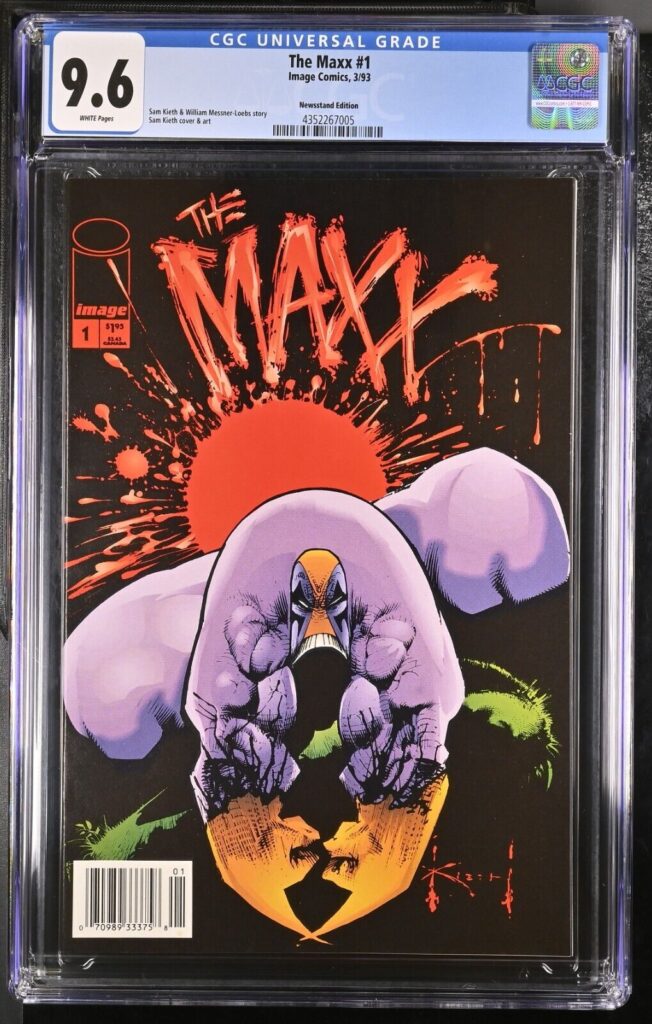
1993 The Maxx #1 NEWSSTAND VARIANT CGC 9.6
The Newsstand Variant cover of The Maxx #1 has a UPC code on the front and features red lettering. In near perfect condition these comic books can sell for $300 or more.

Maxx (1993) #1 Glow-In-The-Dark Edition CGC 9.8
The Maxx #1 comic books are collectible. The Glow In The Dark Edition graded in near perfect CGC 9.8 condition is worth around $300.
Continued Interest: Over the years, “The Maxx” has seen various reprints and new editions, indicating a continued interest in the series. Its unique approach to storytelling and visual style keeps it relevant and intriguing for new generations of comic book readers.
“The Maxx” stands out in the comic book world for its artistic bravery and the depth of its storytelling, maintaining a special place in the annals of comic book history.
“Starman” by James Robinson
DC Comics
A critically acclaimed series from the 90s that redefined the character, yet it often doesn’t receive the same attention as other mainstream DC titles in terms of collectibility. Starman debuted in 1941 and appeared in numerous DC comics over the years.
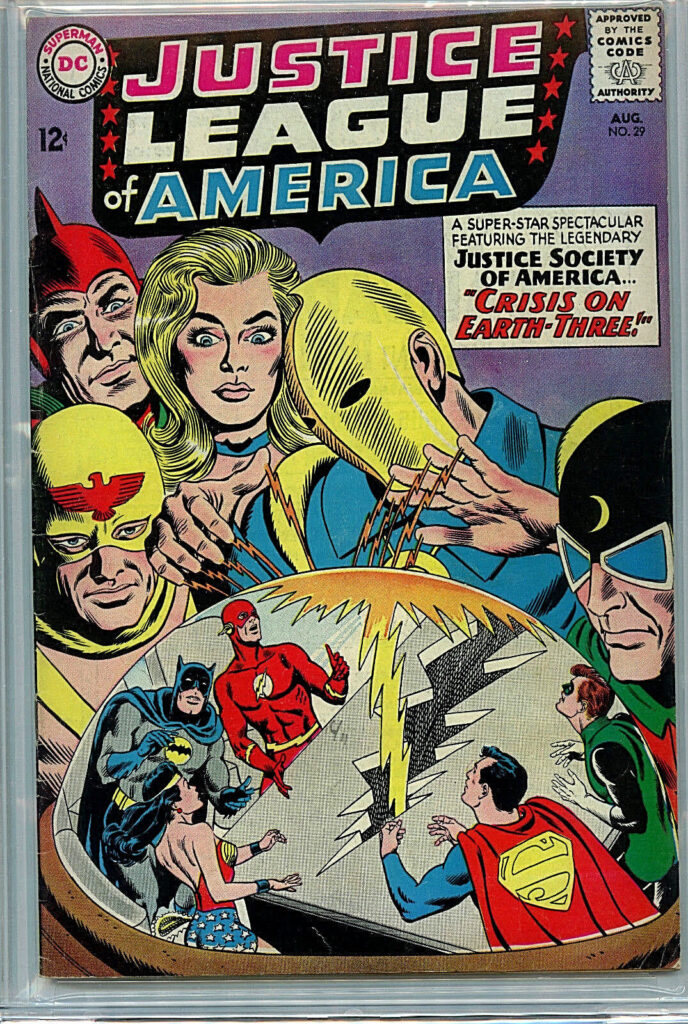
1964 DC Justice League of America #29 comic book is the 1st appearance of Starman in the silver age of comic books.
“Starman” by James Robinson is a comic book series that reimagined the legacy of the classic DC Comics character Starman in a fresh and innovative way. Published by DC Comics, the series ran from 1994 to 2001. Here are some of the key aspects of “Starman” by James Robinson that make the comic book series underrated:

The 1980 DC Adventure Comics #467 is the 1st appearance of Starman as Prince Gavyn. These comic books in near perfect CGC 9.8 condition can sell for around $100.
Main Character – Jack Knight: The series focuses on Jack Knight, the son of the original Starman, Ted Knight. Unlike the traditional superhero persona, Jack is a reluctant hero, often more interested in antiques and collectibles than in crime-fighting.
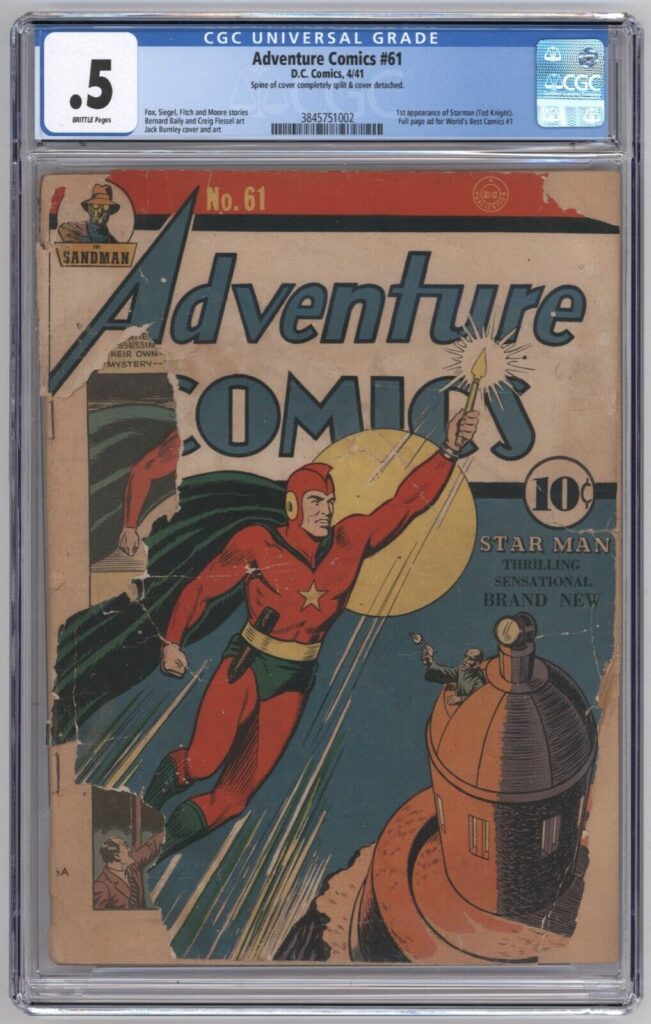
1941 Adventure Comics #61 1st appearance of Starman of Ted Knight the father of Jack Knight.
Unique Approach to Superhero Narrative: Robinson’s “Starman” is noted for its unique approach to storytelling, blending superhero adventures with elements of mystery, family drama, and a deep exploration of legacy and heritage.
Artwork: The series featured artwork by Tony Harris and later by Peter Snejbjerg, among others. The art is notable for its atmospheric and detailed style, which added depth to the series’ rich storytelling.
Opal City: A significant aspect of “Starman” is its setting in Opal City, a beautifully rendered locale with a personality of its own. The city’s art deco design and moody ambiance are integral to the series’ tone.
Critical Acclaim: “Starman” received critical acclaim for its mature and introspective take on the superhero genre. It was praised for its character development, particularly the growth of Jack Knight throughout the series.
Supporting Characters and Villains: The series introduced a variety of interesting supporting characters and villains, some new and some from DC’s vast character roster. This included the Shade, an immortal villain turned ally with a rich backstory.
Crossovers and Continuity: While “Starman” was part of the larger DC Universe, it often felt like a self-contained story. However, it did include crossovers with other characters and events in the DC Comics world.
Awards and Recognition: “Starman” won several awards, including the Eisner Award. It was particularly noted for its innovative narrative approach and its revival of a classic character in a modern context.
Legacy: The series is often cited as one of the best of its era and has influenced how other legacy characters are portrayed in comics. It has a dedicated fan base and is remembered for its depth and emotional resonance.
Collected Editions: After its conclusion, “Starman” was collected in several trade paperback editions, making it accessible to new readers and preserving its place in comic book history.

1994 DC Comics Starman #1 even in perfect condition is only worth the cover price. Signed by James Robinson and Tony Harris and it might sell for $50. A truly under appreciated modern series in the world of comics.
James Robinson’s “Starman” is a standout series in the world of comics, known for its thoughtful storytelling, rich character development, and its unique take on the superhero narrative.
“Concrete” by Paul Chadwick
Dark Horse Comics
A thoughtful and beautifully illustrated series that has been praised for its narrative but is not typically high on collector’s lists.
“Concrete” is a comic book series created, written, and illustrated by Paul Chadwick, first published in 1986. It’s known for its unique blend of realism, philosophical introspection, and a touch of science fiction.
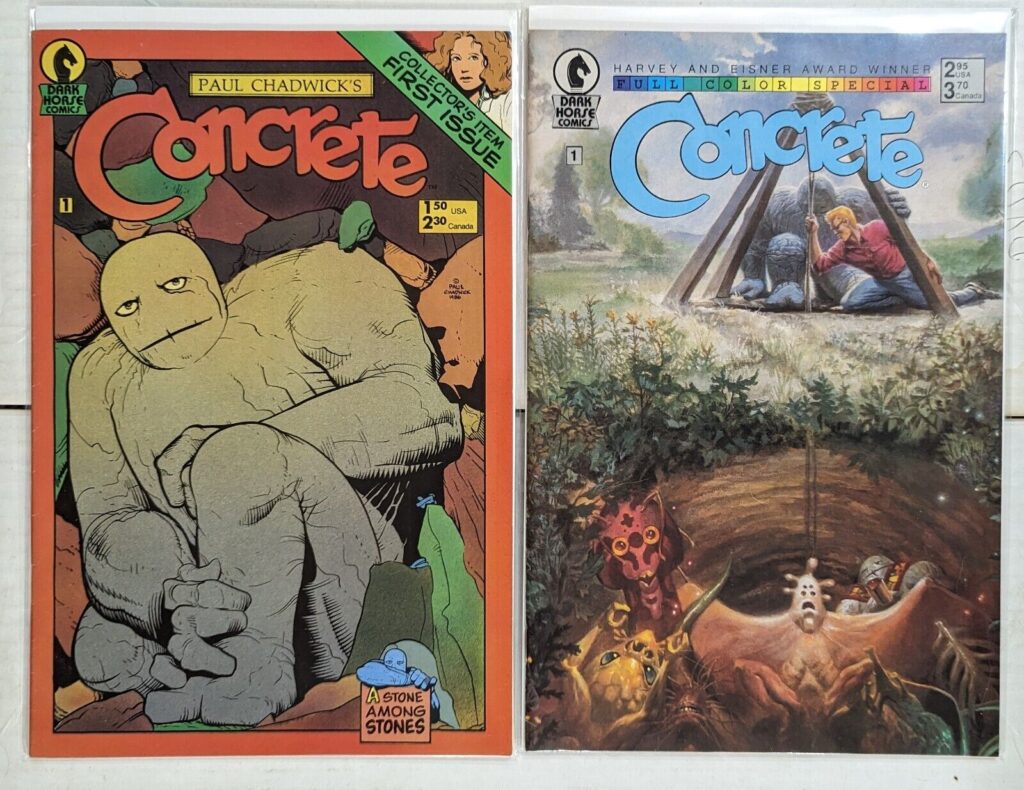
1987 Dark Horse Comics Concrete #1 and Concrete Color Special.
Premise and Main Character: The series revolves around the character Ron Lithgow, a political speechwriter who, through a bizarre series of events involving extraterrestrial beings, finds his mind transplanted into a large, stone-like body. He takes on the name “Concrete” and embarks on a series of adventures and experiences that explore human nature, emotion, and existentialism.
Art and Style: Paul Chadwick’s artwork in “Concrete” is highly detailed and realistic, which sets it apart in the realm of comic books. His illustrations are known for their expressive nature, especially in capturing the human element within the story.
Themes and Narrative: “Concrete” is notable for its exploration of various themes such as environmentalism, individualism, and the human condition. The series is less about superhero battles and more about introspection, human struggles, and the protagonist’s adjustment to his new existence.
Critical Acclaim: The series has been praised for its thoughtful storytelling and has received several awards, including the Eisner Award. Chadwick’s work on “Concrete” has been noted for its depth, creativity, and emotional resonance.
Cultural and Environmental Commentary: “Concrete” often delves into environmental and societal issues, making it relevant and thought-provoking. The series has been used as a platform to explore a wide range of topics from the perspective of its unique protagonist.
Character Development: One of the strengths of “Concrete” is the depth of character development, particularly of Ron Lithgow/Concrete, whose journey of self-discovery and adaptation to his new life forms the heart of the story.
Influence and Legacy: Though not a mainstream comic book in the traditional sense, “Concrete” has had a significant impact on the medium, respected for its unique approach to storytelling and character development.
Collections and Reprints: The series has been collected into various volumes and has been reprinted several times, making it accessible to new audiences and maintaining its place in the comic book world.
Fan Base and Recognition: “Concrete” has a dedicated fan base and is often recommended for readers who are looking for something beyond the typical superhero genre, offering a more introspective and literary experience.
“Concrete” stands out in the world of comics for its innovative approach to storytelling, combining philosophical depth with a unique narrative style, making it a noteworthy series in the genre.
“Planetary” by Warren Ellis
WildStorm/DC Comics
Despite being a well-regarded series for its storytelling and artwork, it tends to be undervalued in the market.
“Planetary” is a comic book series written by Warren Ellis and illustrated by John Cassaday, published by WildStorm, a then-imprint of DC Comics. The series, which ran from 1999 to 2009, is celebrated for its complex storytelling, rich artwork, and innovative exploration of the superhero genre and popular culture.
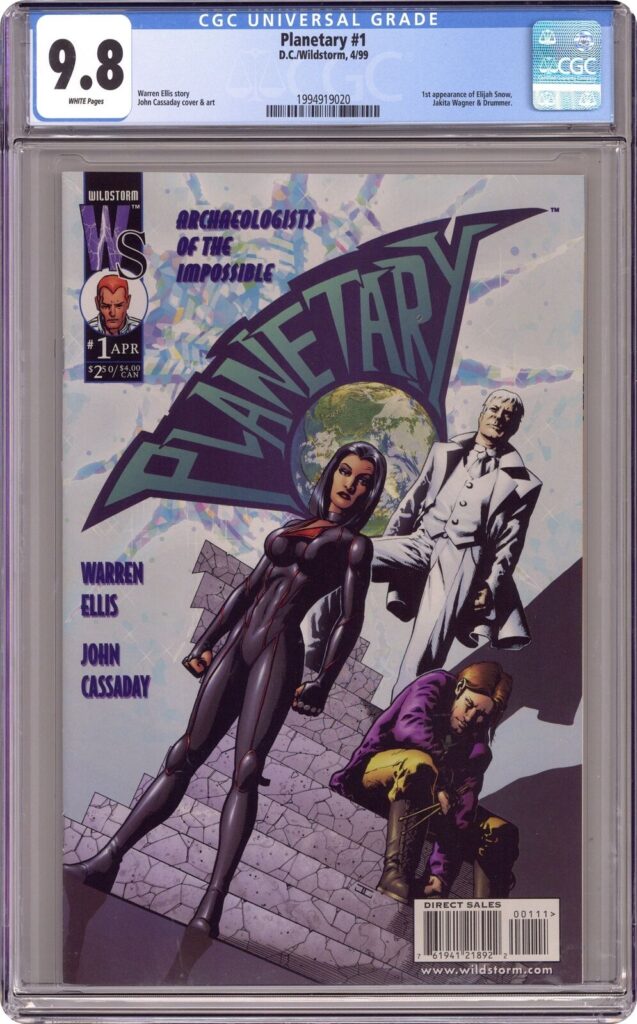
1999 Planetary #1 CGC 9.8 value is worth about $120 in today’s market.
Concept and Main Characters: “Planetary” is centered around a group of mystery archaeologists: Elijah Snow, Jakita Wagner, and The Drummer. They work for an organization called Planetary, dedicated to uncovering the world’s secret history and extraordinary hidden truths.
Genre-Bending Narrative: The series is known for its genre-bending approach, blending elements of superhero comics, science fiction, and horror, among others. It pays homage to and deconstructs various genres and icons of popular culture, from comic books to literature and movies.
Artistic Style: John Cassaday’s artwork in “Planetary” is widely praised for its clarity, detail, and dynamic composition. His visual storytelling, combined with Laura Martin’s coloring, creates a vibrant and immersive world.
Structural Complexity: “Planetary” often employs a non-linear narrative, with each issue exploring a different aspect of the series’ universe, gradually revealing a larger interconnected story. This structure allows for a wide range of themes and stories to be explored.
Thematic Depth: The series delves into themes of power, responsibility, and the nature of history. It explores the idea of cultural icons and archetypes, examining how they shape collective consciousness.
Influences and References: “Planetary” is notable for its numerous references to other works of fiction and real-world figures. The series often features analogues of famous characters from comics (like DC and Marvel superheroes), literature, and other media, reimagined within its universe.
Critical Reception: The series received critical acclaim for its originality, storytelling, and artwork. It won several awards, including Eisner Awards for both Ellis and Cassaday.
Influence on the Genre: “Planetary” has been influential in the comic book industry, particularly in how it handles and reinterprets the superhero genre and popular culture.
Collected Editions: The series has been collected in several trade paperback and hardcover editions, making it accessible to a wide audience and allowing readers to appreciate its complex narrative in a collected form.
Legacy: “Planetary” is often cited as one of the best comic book series of its time, appreciated for its innovative approach and contribution to the medium. During the early 2000’s the series was nominated for several Eisner Awards.
Warren Ellis’s “Planetary” stands as a unique and significant work in the comic book world, offering a rich and layered reading experience that explores and celebrates the diversity of genres in popular culture.
“Doom Patrol” by Grant Morrison
DC Comics
Morrison’s run on “Doom Patrol” is famous for its creativity and influence but is sometimes underrated in the collector’s market.
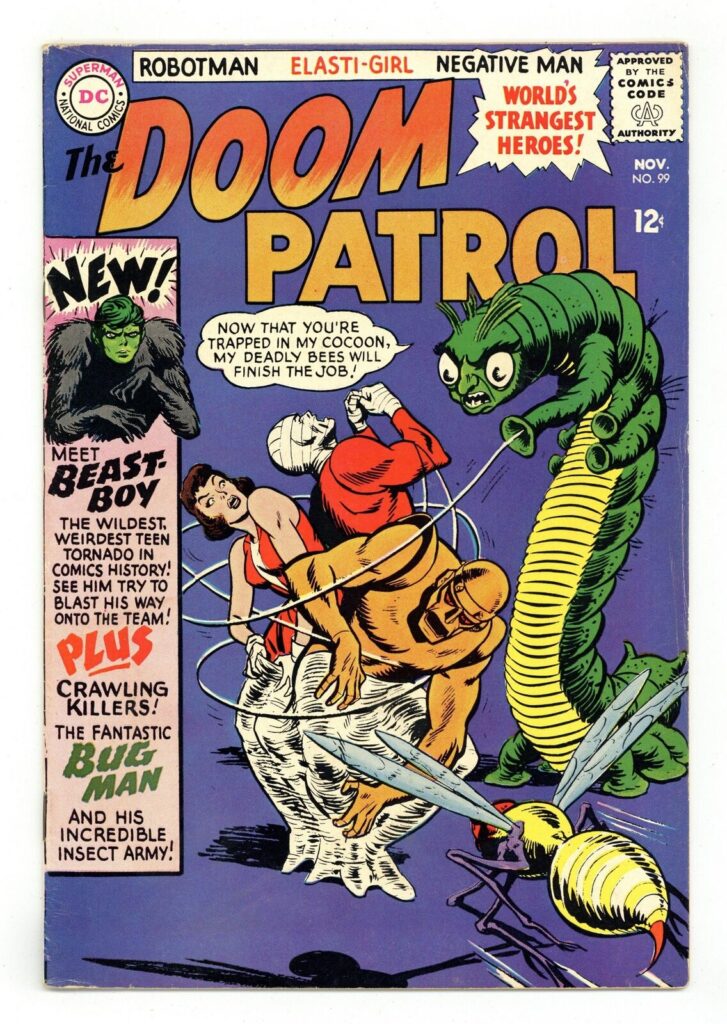
One of the most valuable Doom Patrol comic books is issue #99 that is the 1st appearance of Beast-Boy.
“Doom Patrol” by Grant Morrison is a seminal comic book run that stands as one of the most innovative and influential works in the medium. Morrison took over the writing of “Doom Patrol” with issue #19 in 1989 and continued until issue #63 in 1993, transforming the series into a surreal, avant-garde exploration of superhero tropes, psychological themes, and bizarre narratives.
Revitalization of the Series: Before Morrison, “Doom Patrol” was a relatively obscure title in DC Comics’ lineup. Morrison revitalized the series with a radical new direction, focusing on surrealism, absurdity, and complex storytelling.
The Team: “Doom Patrol” under Morrison featured a roster of unique and often troubled superheroes, including Cliff Steele (Robotman), Crazy Jane (with multiple personalities, each with a different superpower), Rebis (a merged being of a pilot, a female doctor, and a negative energy entity), and others. Morrison expanded the team’s lineup with equally unusual characters.
Thematic Depth: Morrison’s run is known for its deep exploration of themes such as identity, trauma, mental illness, and the nature of reality. The stories often delved into abstract concepts and existential questions, challenging the norms of superhero narratives.
Genre-Bending Narrative: The series blended elements of science fiction, horror, and surrealism. Morrison introduced concepts like the fictional city of Danny the Street, a sentient, transvestite street, and the Brotherhood of Dada, a group of absurdist supervillains.
Artistic Collaborations: Morrison’s “Doom Patrol” featured collaborations with various artists, including Richard Case, whose visuals were integral to realizing the surreal and often chaotic world of the series.
Influence and Legacy: Morrison’s run on “Doom Patrol” has been highly influential, not only within the superhero genre but also in the broader realm of comic book storytelling. It paved the way for more experimental and unconventional narratives in mainstream comics.
Critical Reception: The run was critically acclaimed for its originality, bold storytelling, and subversion of typical comic book conventions. It has been praised for its imaginative approach and for pushing the boundaries of what superhero comics can be.
Collected Editions and Reprints: Morrison’s “Doom Patrol” has been collected in multiple formats, including trade paperbacks and deluxe editions, allowing new generations of readers to discover this groundbreaking series.
Cultural References: Morrison’s “Doom Patrol” is filled with cultural, literary, and philosophical references, adding layers of depth and intertextuality to the reading experience.
Impact on Doom Patrol’s Legacy: Morrison’s work on the series is often seen as the definitive version of “Doom Patrol,” influencing how the characters and the team have been portrayed in subsequent comic book series and adaptations, including the recent TV series adaptation.
Grant Morrison’s “Doom Patrol” remains a landmark in comic book history, celebrated for its daring creativity and profound impact on the genre.
“Stray Bullets” by David Lapham
El Capitán Books
An independent series known for its storytelling and art, yet not as widely collected as other series.

“Stray Bullets” is an independent comic book series written and illustrated by David Lapham. It was first published in 1995 by El Capitan Books, Lapham’s own publishing company. The series is known for its gritty narrative style and its exploration of complex themes, including crime, violence, and the darker aspects of human nature.
Noir-Influenced Storytelling: “Stray Bullets” has a strong noir influence, characterized by its dark, realistic, and often violent stories. The series delves into the lives of various characters, each dealing with their own struggles and moral dilemmas.
Interconnected Stories: The series is notable for its interconnected stories. While each issue can stand alone, they collectively create a larger narrative tapestry. Characters and events from one story often reappear or are referenced in others, creating a rich and cohesive world.
Character-Driven Plots: Lapham focuses heavily on character development. His characters are complex and multi-dimensional, often facing challenging circumstances that test their morals and resilience.
Art Style: Lapham’s art in “Stray Bullets” is distinctive. His use of black-and-white illustrations enhances the gritty and raw atmosphere of the stories. The visual style complements the tone of the narrative, adding depth and emotion to the storytelling.
Critical Acclaim: The series has been praised for its original storytelling and artistic style. It has won several awards, including the Eisner Award, and has been lauded for its unique approach to the crime genre.
Influences and Impact: “Stray Bullets” has influenced other creators in the comic book industry, particularly those working in the crime and noir genres. Its impact is seen in the way it blends traditional noir elements with innovative storytelling techniques.
“Stray Bullets” remains a seminal work in the realm of independent comics, known for its bold storytelling and its unflinching exploration of the human condition through the lens of crime and violence.
“The Question” by Dennis O’Neil
DC Comics
A critically acclaimed series that is often overshadowed by more popular superhero comics.
“The Question” made his first appearance in Charlton Comic’s Blue Beetle #1 (1967) before being acquired by DC Comics in the 1980’s. These comic books in high grade condition are very valuable. Often worth $500 or more.
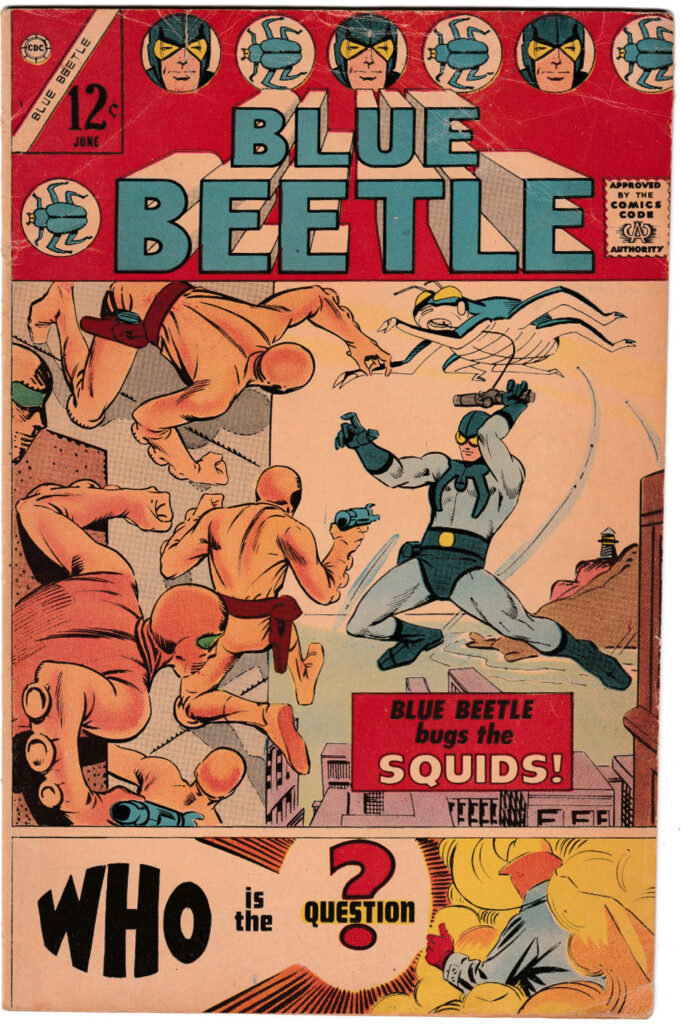
“The Question” by Dennis O’Neil is a significant comic book series that revitalized the character of The Question, originally created by Steve Ditko. Under O’Neil’s direction, the series took on a more philosophical and morally complex tone, differentiating itself from many mainstream superhero comics of its time. It remains a significant work in the history of comic books, particularly for fans who appreciate comics with a deeper narrative and philosophical bent. It was published by DC Comics, starting in the late 1980s.
The Character: The Question, whose real name is Vic Sage, is a faceless hero known for his featureless mask and trench coat. He is a journalist and investigative reporter in his civilian life, which plays a significant role in his approach to crime-fighting. The character is deeply introspective and philosophical, often questioning the nature of morality and justice. The series is set in the fictional city of Hub City, a corrupt and troubled place where Sage, as The Question, seeks to uncover the truth and fight injustice.
Philosophical and Moral Exploration: O’Neil’s version of The Question delves deeply into themes of ethics, philosophy, and the nature of good and evil. This was a stark contrast to the more straightforward crime-fighting narratives common in superhero comics of that era. The series often explored the gray areas of morality, challenging readers to think critically about the nature of justice.
Zen and Eastern Philosophy: A significant element of O’Neil’s run was the incorporation of Zen and Eastern philosophies. The Question undergoes a transformative journey, both physically and spiritually, under the guidance of his mentor, the martial artist and philosopher Richard Dragon. This aspect brought a unique flavor to the series, differentiating it from other superhero stories.
Realism and Social Commentary: The series was known for its realistic approach to storytelling. O’Neil often included social and political commentary within the narrative, addressing real-world issues and reflecting the complexities of contemporary society.
Artistic Style: The art in “The Question,” primarily by Denys Cowan, complemented O’Neil’s writing with a gritty and expressive style. The use of shadows and noir-inspired elements helped to create an atmosphere that was both moody and intense, enhancing the series’ thematic depth.
Legacy and Influence: Dennis O’Neil’s run on “The Question” is highly regarded for its mature and thoughtful approach to the superhero genre. It has influenced numerous writers and artists and is considered a classic example of character-driven storytelling in comics.
Critical Acclaim: The series received critical acclaim for its innovative storytelling and depth. It is often cited as one of the best comic book runs of its time, notable for elevating the medium’s narrative possibilities.
“Scalped” by Jason Aaron
Vertigo/DC Comics
A modern series with a loyal fan base, but hasn’t reached the heights of value that some other Vertigo titles have.
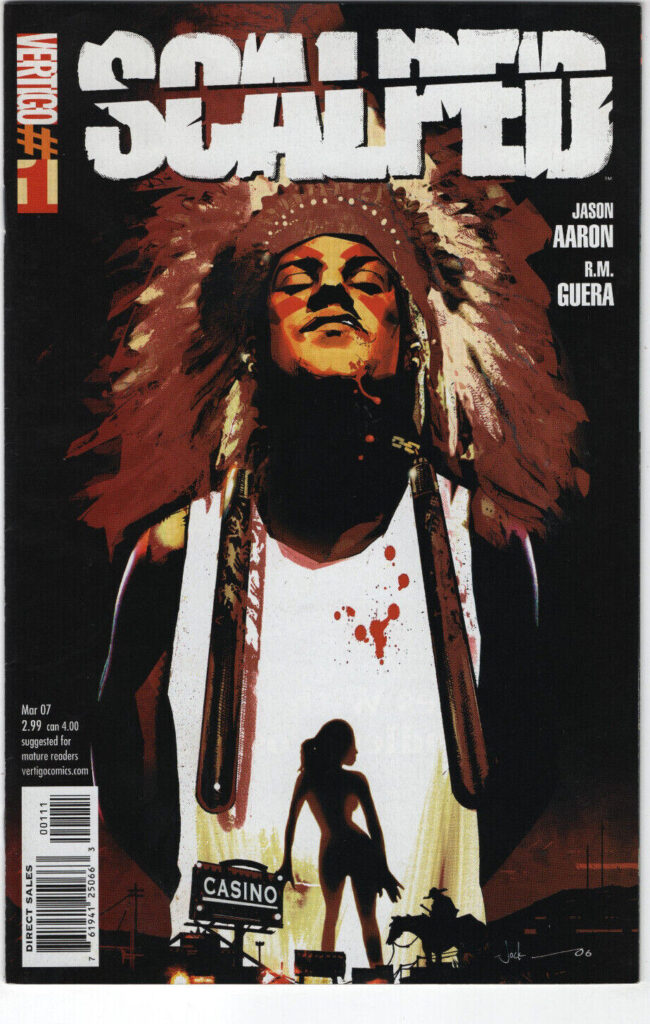
“Scalped” is a critically acclaimed comic book series written by Jason Aaron and illustrated by R.M. Guéra. It was published by Vertigo Comics, an imprint of DC Comics, and ran from 2007 to 2012. The series is known for its gritty, realistic portrayal of life on a Native American reservation, blending crime noir with social and political themes.
Setting and Premise: “Scalped” is set in the fictional Prairie Rose Indian Reservation in South Dakota. The story revolves around Dashiell “Dash” Bad Horse, who returns to the reservation after a long absence. Dash becomes involved in the complex web of crime, corruption, and tribal politics that plague the community.
Themes and Issues: The series tackles a variety of serious issues, including poverty, drug addiction, cultural identity, and the struggle for sovereignty within Native American communities. It also explores themes of redemption, loyalty, and the search for personal and cultural identity.
Complex Characters: “Scalped” is known for its deep, complex characters. Dash Bad Horse, the protagonist, is a deeply flawed individual whose actions and motivations are explored in detail. Other characters, including tribal leader Chief Lincoln Red Crow and FBI agent Nitz, are equally complex and add multiple perspectives to the narrative.
Noir-Influenced Storytelling: The series is heavily influenced by the noir genre, featuring a dark, gritty atmosphere, moral ambiguity, and intense, often violent, plotlines. The noir elements are used effectively to highlight the struggles and realities of life on the reservation.
Artistic Style: R.M. Guéra’s artwork in “Scalped” is notable for its gritty realism and expressive style. The use of shadow and light adds to the noir atmosphere, while the detailed portrayal of the reservation brings a strong sense of place to the story.
Critical Acclaim and Cultural Impact: “Scalped” has been widely praised for its storytelling, character development, and honest portrayal of life on a Native American reservation. It has been recognized for bringing attention to issues facing Native American communities and for its nuanced depiction of those communities.
Influence on the Comic Industry: “Scalped” is regarded as a groundbreaking series in the realm of crime comics, known for its mature themes and realistic portrayal of a seldom-seen segment of American life. It has influenced other creators and is often cited as a significant work in the genre.
Overall, “Scalped” is a powerful, thought-provoking series that combines elements of crime, drama, and social commentary, offering a unique and unflinching look at the modern American experience through the lens of its Native American characters.
“Locke & Key” by Joe Hill
IDW Publishing
Despite its critical acclaim and a successful Netflix adaptation, early issues and limited editions are often undervalued.
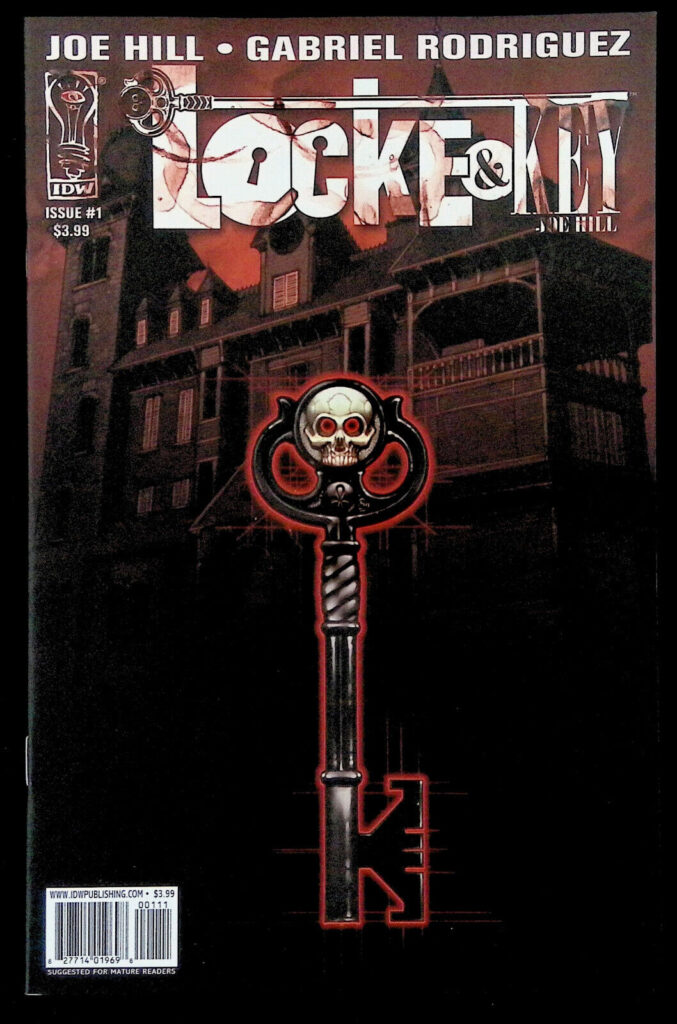
“Locke & Key” is a comic book series written by Joe Hill and illustrated by Gabriel Rodríguez. It was published by IDW Publishing, with the first issue released in 2008. The series quickly gained recognition for its unique blend of horror, fantasy, and family drama.
Story and Setting: The narrative centers around the Locke family, who move to their ancestral home, Keyhouse, in Lovecraft, Massachusetts, after a tragic and violent event. The house is filled with mysterious keys, each possessing unique and often supernatural powers. The series blends elements of horror, fantasy, and mystery as the Locke family uncovers the secrets of Keyhouse and faces various threats.
Supernatural Elements: A significant aspect of “Locke & Key” is its use of magical keys, each with different abilities and powers. These keys become central to the plot, with the characters discovering and utilizing them in various ways. The supernatural elements are seamlessly integrated into the story, adding depth and intrigue to the narrative.
Character Development: The series focuses heavily on the development of its characters, particularly the Locke children: Tyler, Kinsey, and Bode. Their individual journeys, dealing with trauma, growing up, and discovering their identities, are central to the story.
Artwork: Gabriel Rodríguez’s artwork in “Locke & Key” is notable for its detailed and expressive style. The art complements the tone of the story, capturing both the eerie atmosphere of Keyhouse and the emotional depth of the characters.
Themes: “Locke & Key” explores various themes, including grief, family, identity, and the nature of evil. The series is adept at handling complex emotional and psychological themes, adding a layer of depth that transcends typical horror or fantasy stories.
Critical Acclaim and Awards: The series has been praised for its original storytelling, character development, and artwork. It has received numerous awards and nominations, including the British Fantasy Award and the Eisner Award.
Influence and Adaptations: “Locke & Key” has been influential in the comic book industry, particularly in the horror and fantasy genres. It has also been adapted into other media, including an audiobook and a television series, further expanding its reach and impact.
Overall, “Locke & Key” by Joe Hill and Gabriel Rodríguez is a standout series in the realm of modern comics. It is celebrated for its imaginative storytelling, richly developed characters, and its successful fusion of horror, fantasy, and family drama.
“Bone” by Jeff Smith
Independently Published
A highly influential independent comic that, despite its acclaim, doesn’t always get the recognition it deserves in terms of value.

“Bone” is an acclaimed independent comic book series created, written, and illustrated by Jeff Smith. First published in 1991, it ran for 55 issues, concluding in 2004. The series is notable for its unique blend of humor, fantasy, and adventure, and is often compared to classic works like “The Lord of the Rings” and Walt Kelly’s “Pogo” for its mix of whimsical characters and epic storytelling.
Story and Characters: The story follows the adventures of the Bone cousins – Fone Bone, Phoncible P. “Phoney” Bone, and Smiley Bone – who are expelled from their hometown of Boneville and find themselves in a vast, uncharted desert. They eventually reach a mysterious valley filled with wonderful and terrifying creatures. The narrative weaves their journey with that of the valley’s inhabitants, including a young girl named Thorn and her grandmother, Gran’ma Ben.
Art Style: Jeff Smith’s art in “Bone” is highly distinctive, featuring a clean and expressive line style that brings the characters and the world to life. The characters are cartoonish and whimsical, contrasting with the more realistically drawn and detailed backgrounds and other creatures, creating a unique visual experience.
Genre Blending: “Bone” masterfully blends elements of fantasy, comedy, and adventure. The story starts light and humorous, but gradually takes on a darker and more epic tone as it delves into complex themes and a richly developed fantasy world.
Themes: The series explores themes of heroism, friendship, and the battle between good and evil. It also touches upon more profound themes such as loyalty, sacrifice, and the nature of destiny.
Critical Acclaim and Awards: “Bone” has been widely praised for its storytelling, artwork, and creativity. It has won numerous awards, including multiple Eisner Awards and Harvey Awards, and is often cited as one of the greatest graphic novel series of all time.
Influence and Legacy: Jeff Smith’s “Bone” has been influential in the world of comics and graphic novels, particularly in how it bridged the gap between traditional comic books and the emerging graphic novel format. Its success as an independently published series has inspired many other creators in the field.
Adaptations and Merchandise: “Bone” has been adapted into various formats, including video games and a series of novels. Plans for an animated adaptation have been discussed over the years, reflecting the series’ enduring popularity.
Readership: Initially aimed at a younger audience, “Bone” has garnered a broad fan base of all ages, appreciated for its depth, humor, and universal themes.
Overall, “Bone” by Jeff Smith stands out as a landmark in the field of graphic novels. Its combination of endearing characters, imaginative storytelling, and beautiful artwork has earned it a special place in the hearts of readers and a significant spot in comic book history.
